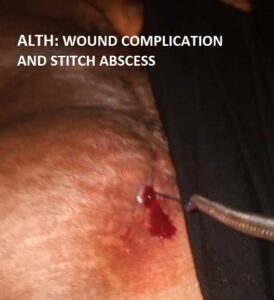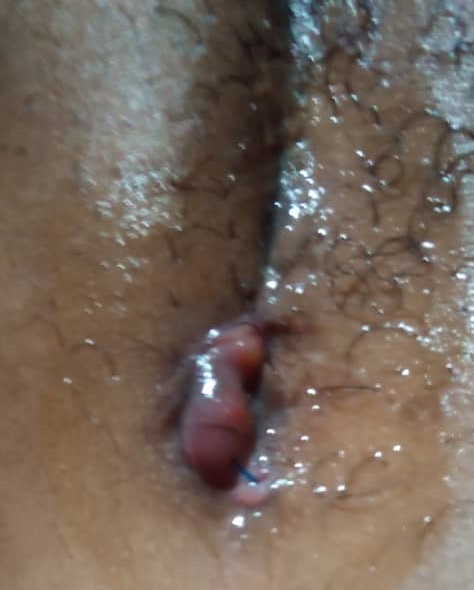A surgical wound is a cut or incision in the skin that is usually made by a scalpel during surgery. Stitches also referred to as sutures, are thin loops of thread that are used to bring together and close the edges of a wound. Meanwhile, an abscess is an enclosed collection of liquefied tissue, known as pus, somewhere in the body. It is the result of the body’s defensive reaction to foreign materials, this can be caused by many factors, however, the leading causative will be enumerated.
Wound Complication in post-surgery.
Obviously, many factors can lead to the complication of wound after opening up or surgery, amongst them are the chief causes which are: infection, or the patient’s immune system condition or managing another disease before the surgery such as diabetes.
Types of wound complication in post-surgery stitch abscess
It is broadly grouped into four group classes:
Class I: These are considered clean wounds. They show no signs of infection or inflammation. They often involve the eye, skin, or vascular system.
Class II: These wounds are considered clean-contaminated. Although the wound may not show signs of infection, it is at an increased risk of becoming infected because of its location. For example, surgical wounds in the gastrointestinal tract may be at a high risk of becoming infected.
Class III: A surgical wound in which an outside object has come into contact with the skin has a high risk of infection and is considered a contaminated wound. For example, a gunshot wound may contaminate the skin around where the surgical repair occurs.
Class IV: This class of wound is considered dirty-contaminated. These include wounds that have been exposed to fecal material.


Causes of infected wound complication in post-surgery
Our skin provides us with a natural barrier to infection. It’s very hard for germs to enter the body through intact skin. This changes when the skin is broken, as the wound provides germs with a direct route to the inside of the body.
Infected stitches are most often caused by bacteria. Common types of bacteria that can infect wounds include Streptococcus, Staphylococcus, and Pseudomonas species.
Aside from bacterial as the leading cause, there are some unhygienic factors that set you at risk, they are:
- Improper cleaning of the wound by the surgeon stitching
- Inadequate or lack of effective sanitization of the surgical environment before starting the procedure
- Having prolonged wound healing history
- Managing a deep wound before the operation or stitching
- Long surgical operation session which can breed infection if not properly handled
- Use of bleaching or toning creams on the epidermal layer of the skin
- Aged patients with wrinkled skin are also at risk
- Weakened immune system due to present ailment such as HIV/AIDs, cancer or anaemia, hepatitis etc.
- High blood sugar delays wound healing which can cause infection with an abscess
- History of smoking or a regular alcoholic consumer beyond measure
- Use of dirt and questionable water when bathing
- Adopting local measure of heating up the wound region without doctor’s nod
- Frequent exposure of the wound to ambience
- Swimming when the wound isn’t yet proper healed
- Undergoing undue stress when the wound is not yet healed
- Creating abdominal pressure be it accidental or intentional
Possible indications in detecting wound complication and stitch abscess in post-surgery
Stitch abscess is the last stage of a tissue infection that begins with a process called inflammation. Initially, as the invading germ alleviate the body’s immune system, several events occur:
- Blood flow to the area increases.
- The temperature of the area increases due to the increased blood supply.
- The area swells due to the accumulation of water, blood, and other liquids.
- It turns red or swelling around the stitches
- It hurts, because of the irritation from the swelling and the chemical activity.
- Unusual fever
- An increase in pain or tenderness at the wound
- Blood or pus leaking from the stitches, which may have a foul odor
- Swollen lymph nodes


Possible preventions of wound complication and stitch abscess in post-surgery
The prevention is so effective if it is not caused by poor hygiene and incompetence of health giver, therefore, I will recommend that you use a hospital with sound track record in surgery (ALTH is one with a proven record).
Other preventions are:
Keep your stitches dry
You should avoid getting your stitches wet for at least 24 hours. Ask your doctor when you can get them wet, such as in the shower. Avoid soaking in a tub or swimming while you’re healing. Always be sure to gently pat your stitches dry with a clean towel after getting them wet.
Keep your stitches clean
If your doctor has placed a bandage or dressing on your stitches, be sure to follow their instructions about when to remove it. Use soap and warm water to gently clean the stitches, patting dry with a clean towel.
Avoid touching your stitches
If you must touch your stitches, make sure that your hands are clean beforehand. You naturally have bacteria living on your skin and under your fingernails. Itching, scratching, or picking at your stitches can lead to infection.
Avoid strenuous activities
Exercise and contact sports can place strain on your stitches, causing them to tear and possibly, having abscess. Refrain yourself until you are approved by the doctor.
Use of an unhygienic local method
The use of heat to radiate the wound if not prescribe is dangerous, it may cause lesion with huge possibility of abscess if not stop on time. Therefore, seek medical counsel before you result into local approach.
From Adebayo Living Tower Hospital Doctor’s desk
Dear patient, you have nothing to worry about if you notice stitches abscess in your post-surgery, this could be caused by one of the reasons highlighted above. Therefore, you are warmly counsel to present yourself for a medical check-up at our hospital to avoid compilations or another surgical opening.
Above all, if you notice any warmth or usual wetness around the surgical wound, waste no time nor get confused, we are disposed to deliver optimum and qualitative health service.





Recent Comments